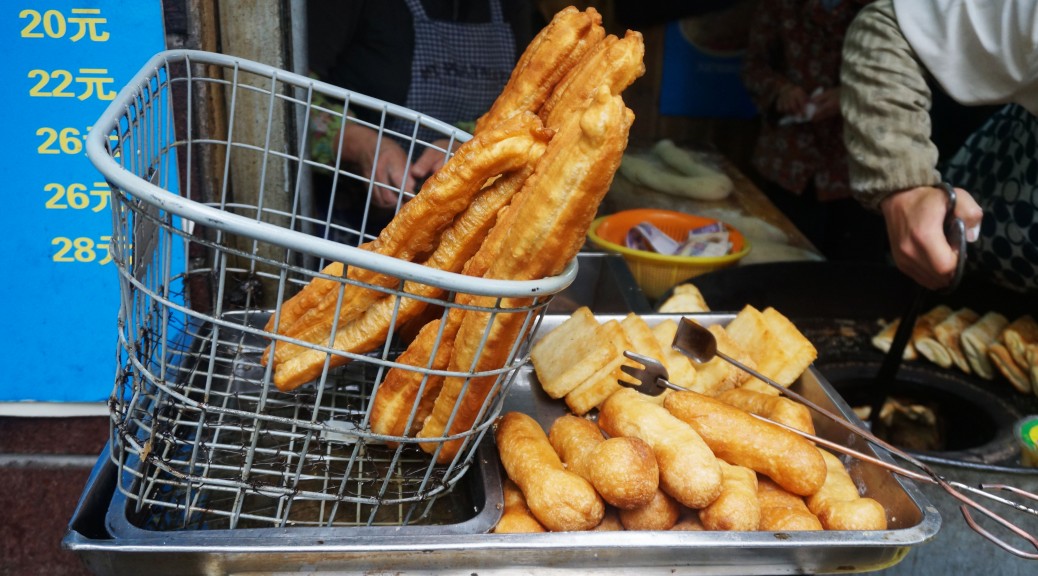Yóu Tiáo (Chinese: 油条), also known as Chinese cruller, oil stick, doughnut, and breadstick, is a trip of fried dough that is typically eaten for breakfast. It usually is served as an accompaniment with rice congee, soy milk, or tofu soup where they are either served whole to be dipped into the liquid or cut into smaller pieces to be sprinkled on top. They are lightly salted and fried in pairs with the center attached so that the dough becomes puffy and crispy on the outside and soft and chewy on the inside. You tiao is best eaten immediately after it is fried because of its tendency to become tough or elastic-y if left out for too long. At breakfast, you tiao, can be stuffed inside various carbohydrates such as roasted flatbread (shaobing), rice noodle (zhaliang), or glutinous rice (cifan). Its sweet version is named tang gao, which is similar in appearance to youtiao but shorter in length.
Ingredients:
You tiao contains flour, water, sugar, salt, baking soda and vegetable oil. Street vendors usually add alum, potassium aluminum sulfate crystals, to recipes in order to increase the puffy, crispy exterior of their bread.
Cooking Method:
All ingredients are combined to form a soft dough, which is kneaded and left to rest two to three times. The dough is brushed with oil and folded then cut into smaller pieces to be stretched out and twisted together into pairs. A wok of oil is heated before the strips of dough are deep-fried till golden.
History:
You tiao is nicknamed you zha gui, or deep fried ghost, which stems from a story told long ago during about a public protest that took place during a rather heavy and serious part of Chinese history. The protest involved a famous and well-respected General, Yue Fei, who was appraised by the people for his loyalty towards the Song Dynasty and his Emperor during his time at war defending the kingdom from outer invasions, particularly the Jin Dynasty.
At that time, the Prime Minister, Qin Kuai, and his wife, Wang, grew jealous of him and formed a secret liaison with the invading northern tribe of the Jin Dynasty to frame Yue Fei under accusations of a crime and get him executed. Public civilians were frustrated by their inability to defend their General; so in reaction, a shao bing vendor and ci fan tuan vendor decided that they should devise a way to express their opinions. The pancake vendor decidedly sculpted two miniature people out of dough, representing Qin Kuai and Madam Wang. He then began slashing at their figures with his dough cutter. The other vendor brought his deep-fry wok, twisted the two figures together into one piece of dough with their backs to each other, and threw them into the wok full of searing oil.
While they were frying, the vendors called out for people to see. As a crowd of passer-byers formed to see the two ugly figures sizzling in the hot oil, they immediately called out, “Fried Kuai!” At the same time, Qin Kuai happened to pass this spectacle on his way from the imperial palace and was enraged with disbelief by the mutiny of his edible figure.
In the vendors’ defense, two men stepped up and scooped the fried dough out of the oil to eat it. They exclaimed how delicious and crispy it was, which further infuriated Qin Kuai. The two food vendors combined businesses to continue making the fried Kuai. Soon, their business was so busy that they had to design a simpler version of fried Kuai that was made of two strips of dough twisted together in order to represent Qin Kuai and his wife. The street food sensation quickly spread to other cities of China and eventually given the name, “you tiao.”
During the Cultural Revolution in China, educated youths used food-related propaganda as a way of symbolically addressing issues aimed at the laobaixing. A well-known street food youtiao, a deep-fried cruller that literally translates to “oily strip,” appeared as a political emblem as the cheapest and lowliest form of Shanghai street food. It came to represent the poor economic realities of students receiving government scholarships who could only afford to eat, at most, three youtiao a day. These student activists wanted to motivate the government to fund schools and provide living stipends for intellectuals.
Possible Variations:
ci fan tuan – Chinese cruller stuffed stuffed in a glutinous rice ball
shaobing youtiao – Chinese cruller inside roasted flatbread
zha liang – Chinese cruller inside rice noodle roll
tang gao – Sugar doughnut
